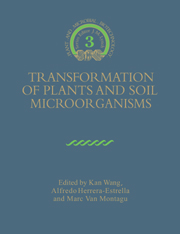Preface
Published online by Cambridge University Press: 04 August 2010
Summary
Advances in biology continue to be made at a striking and ever increasing rate, especially since the powerful technique of gene manipulation became available. For plant biologists, however, the possibility of engineering plants was not considered until the mid 1970s, when gene transfer mediated by the soil bacterium Agrobacterium tumefaciens was discovered. From this moment on, enormous developments have occurred concerning not only practical aspects such as crop improvement but also fundamental aspects relating to the understanding of the biology of plants in their interactions with the environment. One of the most important subjects is perhaps that of plant-microbe interactions.
For either applied or academic research, it is essential to establish efficient transformation systems. Although the basic transformation techniques have been well established for model systems such as Escherichia colt, yeast and tobacco, many important species have proven more difficult to manipulate. During the past several years, many research groups took up the challenge of transformation and have made significant progress. To keep abreast with this rapid development, we have invited in this volume several leading groups to share their experiences with prospective and practicing researchers in the microbe/plant field. Together, we have endeavored to give readers details of one particular problem of major importance – transformation of soil microorganisms and recalcitrant crops.
Part I consists of four chapters on the transformation of soil microorganisms. Each chapter describes most, if not all, techniques used for transformation in the laboratory of a specific microbe.
- Type
- Chapter
- Information
- Publisher: Cambridge University PressPrint publication year: 1995



